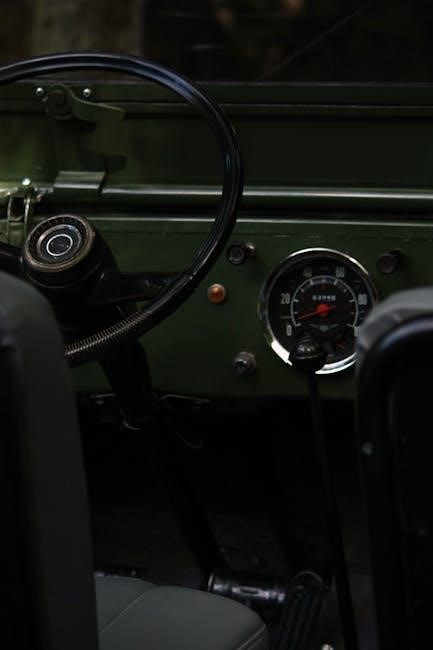
Manual steering is a fundamental driving mechanism offering direct road feedback and control. It relies on mechanical connections, providing drivers with precise vehicle handling and responsiveness, essential for understanding steering principles in both classic and modern vehicles.
1.1 What is Manual Steering?
Manual steering is a driving system that relies on mechanical components to connect the steering wheel directly to the vehicle’s wheels. Unlike power steering, it does not use hydraulic or electric assistance, requiring the driver to exert physical effort to turn the wheels. This system provides direct feedback from the road, allowing drivers to feel the vehicle’s response to surface conditions, such as bumps or traction changes. Manual steering is often associated with classic or older vehicles but is still valued for its simplicity, reliability, and ability to deliver precise control. It requires the driver to engage more actively with the vehicle, enhancing the driving experience for those who prefer a hands-on approach.
1.2 Importance of Manual Steering in Driving
Manual steering plays a crucial role in driving by providing direct feedback from the road, allowing drivers to better understand vehicle behavior. This system enhances control, as drivers must actively manage the steering wheel, improving reaction times and decision-making. The absence of power assistance requires more physical engagement, fostering a deeper connection between the driver and the car. Manual steering also promotes situational awareness, as drivers can feel surface irregularities and traction changes. This mechanical simplicity makes it inherently reliable, with fewer components prone to failure. For drivers who value precision and a hands-on experience, manual steering offers a more immersive and skill-oriented driving experience, making it a preferred choice for certain driving conditions and vehicle types.

Components of a Manual Steering System
A manual steering system consists of a steering wheel, column, gear, and linkage system, working together to transmit driver input into precise vehicle direction control mechanically.
2.1 Steering Wheel and Column
The steering wheel and column are the primary interface between the driver and the vehicle. The steering wheel, typically circular, is designed for comfortable grip and control, while the column connects it to the steering gear. Modern columns often feature tilt and telescoping adjustments for driver comfort. The column houses the shaft that transmits the driver’s rotational input to the steering gear. Safety features like collapsible columns protect drivers in collisions. Together, they ensure precise control and comfort, essential for safe and effective vehicle operation.
2.2 Steering Gear and Linkage
The steering gear and linkage are critical components that convert the driver’s input into directional movement of the wheels; The steering gear, typically a gearbox, translates the rotational motion of the steering column into linear motion. This is achieved through systems like recirculating ball or rack-and-pinion mechanisms. The linkage, including tie rods and drag links, connects the gear to the wheels, ensuring precise alignment and response. The steering gear provides mechanical advantage, reducing effort needed to steer, while the linkage ensures smooth transmission of forces. Proper alignment and lubrication of these components are essential for reliable operation and precise control, making them vital for safe and efficient driving.
2.3 Pitman Arm and Idler Arm
The Pitman arm and idler arm are essential links in the steering system, ensuring smooth transmission of motion. The Pitman arm connects the steering gear to the drag link, converting the gear’s linear motion into rotational movement for the wheels. The idler arm supports the drag link, providing a pivot point and maintaining alignment. Both arms are equipped with bushings or joints to allow for smooth movement and reduce wear. Proper lubrication and tight tolerances in these components are crucial for precise steering control and minimizing play, ensuring the vehicle responds accurately to the driver’s input without unnecessary vibration or slack.

How Manual Steering Works
Manual steering operates by converting the driver’s input into precise wheel movement through mechanical components, offering direct road feedback without power assistance, enhancing driver control and sensitivity.
3.1 Mechanical Advantage in Manual Steering
Manual steering systems leverage mechanical advantage through gear ratios and leverage, enabling drivers to steer with less effort. The steering wheel and column act as a lever, multiplying torque applied by the driver. This mechanical advantage reduces the force needed to turn the wheels, making maneuvering easier. Additionally, the recirculating ball or rack-and-pinion mechanisms amplify the turning effect, providing precise control. This system ensures that drivers can navigate various road conditions with confidence, relying on the inherent mechanical benefits of manual steering to maintain stability and responsiveness behind the wheel.
3.2 Recirculating Ball vs. Rack-and-Pinion Systems
Manual steering systems primarily use two mechanisms: recirculating ball and rack-and-pinion. The recirculating ball system employs a worm gear and ball bearings to convert rotational motion into linear movement, offering smooth operation and durability. In contrast, rack-and-pinion systems directly translate steering wheel rotation into lateral movement of the wheels, providing precise control and immediate feedback. While both systems are effective, recirculating ball setups are often found in heavier vehicles due to their robustness, whereas rack-and-pinion systems are common in lighter vehicles for their responsiveness and simplicity. Each design caters to specific driving needs, ensuring efficient steering performance across various applications.

Manual Steering vs. Power Steering
Manual steering offers direct road feedback and better control, while power steering provides ease of use and reduced effort, especially at low speeds, enhancing maneuverability and comfort.
4.1 Key Differences
The primary distinction between manual and power steering lies in the mechanism and effort required. Manual steering relies solely on the driver’s strength and mechanical components, offering precise control and feedback. In contrast, power steering uses hydraulic or electric assistance to reduce steering effort, making it easier to maneuver, especially at low speeds or in tight spaces. Manual systems are lighter and more straightforward, while power steering adds complexity and weight but enhances comfort. Each system caters to different driving preferences and conditions, balancing between driver engagement and ease of use.
4.2 Pros and Cons of Manual Steering
Manual steering offers several advantages, including enhanced driver engagement and precise control, as it directly connects the driver to the road. It provides better feedback, allowing drivers to sense road conditions and vehicle behavior more intuitively. Additionally, manual systems are simpler, lighter, and require less maintenance compared to power steering. However, the downsides include increased physical effort, particularly in low-speed maneuvers or tight spaces. This can be tiring on long drives or in heavy traffic. Manual steering also lacks the convenience of power assistance, making it less accessible for drivers with physical limitations. Despite these trade-offs, many enthusiasts appreciate the direct connection and responsiveness it offers.

Driving Techniques with Manual Steering
Mastering manual steering requires a firm yet relaxed grip, precise hand positioning, and smooth inputs. Drivers must adapt techniques to road conditions, ensuring control and safety.
5.1 Proper Steering Wheel Grip
A proper steering wheel grip is essential for control and safety. Hold the wheel firmly but not rigidly, with hands at 9-3 o’clock positions. Avoid gripping too tightly, as this can cause fatigue and reduce sensitivity to feedback. Keep your hands on the wheel, especially when navigating curves or uneven roads. For precise control, especially in tight maneuvers, slightly adjust your grip to maintain stability. Proper grip ensures quick, accurate steering responses and better overall vehicle handling. This technique is fundamental for mastering manual steering and enhances your ability to adapt to varying driving conditions effectively.
5.2 Hand Positioning for Control
Proper hand positioning on the steering wheel is crucial for maintaining control while driving. Place your hands at the 9-3 o’clock positions for optimal grip and leverage. Avoid holding the wheel at the bottom, as this reduces your ability to maneuver quickly. Instead, keep your hands slightly above the wheel’s center for better responsiveness. Use a firm but relaxed grip, with your fingers wrapping around the wheel and your palms providing support. This positioning allows for precise steering input and helps you maintain control during sharp turns or unexpected road conditions. Consistent hand placement also enhances your ability to feel the road and make smooth, accurate adjustments.
5.3 Steering Techniques for Different Road Conditions
Adapting your steering technique to different road conditions is essential for safe and effective control. On wet or icy roads, reduce your speed and use smooth, gradual steering inputs to avoid losing traction. For uneven surfaces, maintain a firm grip on the wheel to absorb shocks and make precise corrections. When driving on loose gravel or sand, steer lightly to prevent skidding. In heavy traffic or tight spaces, use slow, deliberate movements to navigate accurately. Always adjust your speed according to the road conditions and keep your hands ready to respond quickly. This adaptive approach ensures better vehicle stability and reduces the risk of losing control, making manual steering more manageable and safer in varying environments.

Maintenance of Manual Steering Systems
Regular maintenance ensures optimal performance. Inspect components like the steering gear, Pitman arm, and idler arm for wear. Lubricate moving parts to prevent friction and corrosion. Check fluid levels if applicable. Adjust steering play periodically to maintain precise control. Address any looseness or noise promptly to avoid major repairs;
6.1 Regular Checks and Lubrication
Regular inspections are crucial for maintaining manual steering systems. Start by examining the steering column, gear, and linkage for signs of wear or damage. Lubricate all moving parts, such as the steering gear and joints, using high-quality grease to reduce friction and prevent corrosion. Check the Pitman arm and idler arm for play or looseness, as excessive movement can lead to poor steering control. Additionally, ensure that the steering wheel is securely attached to the column and that all bolts and nuts are tightened to the manufacturer’s specifications. Regular lubrication and checks help maintain smooth operation and prevent premature wear.
6.2 Adjusting Steering Play
Adjusting steering play involves ensuring the steering system operates smoothly without excessive looseness. Start by locating the steering gear and checking for play in the sector shaft or steering box. Use a wrench to tighten the adjusting screw or nut according to the manufacturer’s specifications. For rack-and-pinion systems, inspect the tie rods and steering rack mounting bolts, tightening any loose connections. After adjustments, test the steering by moving the wheel gently to ensure there is no free play. Proper alignment and adjustment prevent uneven tire wear and maintain precise control. Always consult a repair manual for specific instructions, as improper adjustments can lead to unsafe driving conditions.

Troubleshooting Common Issues
Troubleshooting manual steering issues involves identifying symptoms like heavy steering or vibrations. Diagnose problems by inspecting components for wear or damage. Address issues promptly to ensure safe operation.
7.1 Diagnosing Heavy Steering
Heavy steering can be caused by worn or loose components in the steering system. Check the steering gear, linkage, and fluid levels for any signs of wear or leakage. Inspect the power steering belt and pump for proper function. If the system is manual, ensure all joints and connections are tight and properly lubricated. A malfunctioning power steering pump or low fluid levels can also lead to heavy steering. Addressing these issues promptly is crucial for maintaining control and safety while driving. Regular maintenance can help prevent such problems from arising.
7.2 Addressing Steering Wheel Vibration
Steering wheel vibration can be caused by imbalanced tires, misaligned wheels, or worn-out steering components. Start by checking tire pressure and balancing the wheels. Inspect the front-end alignment and ensure it is properly adjusted. Worn or loose parts like the pitman arm or idler arm can also cause vibrations; Lubricate all moving components and tighten any loose connections. If the issue persists, consider replacing damaged parts. Addressing vibration promptly improves driving comfort and safety, preventing further damage to the steering system. Regular inspections and maintenance can help identify and resolve these issues early.

Safety Considerations
Manual steering requires physical effort and attention, making driver fatigue a risk. Ensure proper training, regular inspections, and adherence to traffic laws for safe operation and control.
8.1 Safe Driving Practices with Manual Steering
Safe driving with manual steering involves maintaining proper grip and hand positioning to ensure control. Regular vehicle inspections, including tire pressure and steering components, are crucial. Avoid distractions and keep both hands on the wheel, especially during sharp turns or uneven roads. Anticipate road conditions and adjust speed accordingly. Proper braking techniques, such as downshifting before braking, can reduce strain on the steering system. Stay alert and maintain a safe distance from other vehicles. Following these practices enhances safety and reduces the risk of accidents while driving with manual steering.